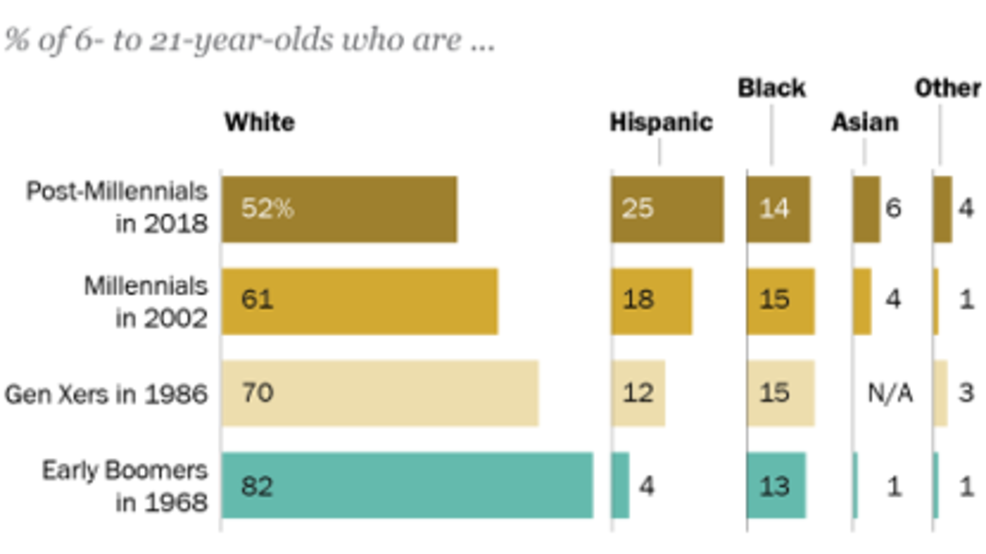By: Hunter Geisel
An analysis from the Pew Research Center states that the “post-Millennial” generation is on track to be the most diverse and educated generation yet.
The Pew Research Center released an analysis of data from the Census Bureau where it found that the post-Millennial generation (also known as “Generation Z”/”Gen-Z”/”Gen-Zers”; “i-Gen”; “Homelanders”) is already the most racially and ethnically diverse generation, and that older members of this generation are enrolling in college at significantly higher rate than the Millennials before them.
According to the analysis, 52 percent of Gen-Zers (roughly now around the ages of 6 to 21) are non-Hispanic white. Meanwhile, 25 percent of Gen-Zers are Hispanic, which is seven percent higher than the previous generation.
Those who identified as Asian or with another ethnic/racial identity grew at least two- to four-percent higher than Millennials. The only demographic that seemed to show little change were black people, which only had a one-percentage point difference between generations.
Although Gen-Zers are more likely to be Hispanic and Asian compared to previous generations, they’re not more likely to be immigrants. The Pew Research Center found that only seven percent of those born in the post-Millennial generation were foreign born, compared to eight percent of Millennials; however, Gen-Zers are more likely to be born in America with at least one foreign-born parent (22 percent) compared to Millennials (15 percent).
In terms of numbers, Millennials were shaped to a much larger extent by young immigrants than Gen-Zers. When Millennials were between ages 6 and 21 in 2002, they numbered at 65.3 million, including 5 million immigrants. Adjacently, only 4.4 million of the 66.5 million Gen-Zers are immigrants – a pattern that the Pew Research Center stated “mirrors” those of Generation X, the generation before Millennials.
Even with the flow of immigrants into the U.S., the racial and ethnic diversity of Gen-Z is expected to increase in the future as new immigrants join their numbers. The Pew Research Center stated that Gen-Zers are projected to become majority nonwhite by 2026 (when they reach the ages of 14 to 29), according to census projections.
The Pew Research Center also found that the geography and mobility of Gen-Z differ from earlier generations.
The analysis stated that Gen-Zers tend to reside in metropolitan areas opposed to rural areas, with only 13 percent of them in rural areas compared to the 18 percent of Millennials, the 23 percent of Gen-Xers and 36 percent of Baby Boomers. America’s urban and western regions are also growing in racial and ethnic diversity, where two-thirds of Gen-Zers living in urban counties aren’t white, with a plurality of the population being Hispanic (36 percent).
When talking about mobility, the Pew Research Center stated that Americans aren’t moving around as much as they used to and Gen-Zers are no exception – 11 percent of Gen-Zers in 2018 had a different address from a year earlier, that implied they moved. Meanwhile, 17 percent of Millennials along with 20 percent of Gen-Xers and Baby Boomers had moved in the past year when they were the ages of Gen-Z.
Education
Initial signs in the census analysis suggested that Gen-Z is on track to become the country’s most well-educated generation yet.
As of 2017, 80 percent of Gen-Zers ages 18 to 20 have finished, representing improvement from previous generations – only 76 percent of Millennials and 78 percent of Gen-Xers completed high school, stated the Pew Research Center. Some of the overall improvements included a leap in high school completion among Hispanic youth, stating that 76 percent of Hispanic Gen-Zers completed high school compared to 60 percent of Hispanic Millennials in 2002. Black high school completion rates also improved, stating that 77 percent of black Gen-Zers completed high school compared to 71 percent of black Millennials in 2002.
Because white Gen-Z high school attainment is no higher among white Millennials, the Pew Research Center suggested that some of the longstanding racial and ethnic gaps in high school completion are narrower among Gen-Zers compared to prior generations.
One of the indicators in these changes suggested that younger Gen-Zers are behind where Millennials were in their progress in K-12 education. In 2017, 30 percent of Gen-Zers ages 6 to 17 were enrolled below the “modal grade,” or the grade which a child is enrolled in at a given age. By comparison, 25 percent of Millennials and Gen-Xers were enrolled below the modal grade in 2002 and 1986, respectively. The Pew Research Center stated that this indicator was valuable because it could foreshadow subsequent dropouts if a child is behind in school because of grade retention. However, it also stated it was unclear whether students are behind because being held back or if their parents started them in kindergarten at an older age.
Outside of K-12 education, Gen-Zers are more likely than earlier generations to pursue college, where in 2017, 59 percent of Gen-Zers ages 18 to 20 who were no longer in high school were enrolled in college. Compared to older generations, only 53 percent of Millennials and 44 percent of Gen-Xers were pursuing college that those ages.
This gain not only comes from racial and ethnic enrollment rates, but also from gender enrollment rates.
According to the Pew Research Center’s analysis, 64 percent of Gen-Z women who were no longer in high school were enrolled in college – that’s up from 57 percent of Millennials and 43 percent of Gen-Xers when they were in those ages.
Workforce
The Pew Research Center suggested that Gen-Zers who are entering adulthood with less experience in the labor force than previous generations.
Roughly 19 percent of Gen-Zers ages 15 to 17 reported to have worked at all during the prior calendar year in 2018, compared to 30 percent of Millennials and 48 percent of Baby Boomers. Among today’s workers ages 18 to 21, 58 percent of them were employed in the prior calendar year. Meanwhile, 72 percent of Millennials and 80 percent of Baby Boomers were employed while they were those ages.












